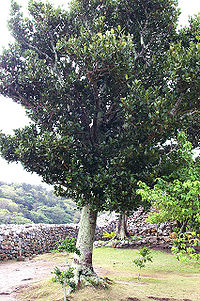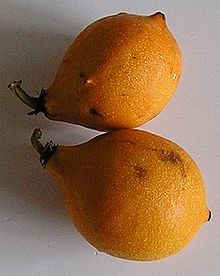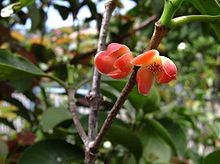- Garcinia
-
Garcinia 
Garcinia subelliptica, known as fukugi in Japan Scientific classification Kingdom: Plantae (unranked): Angiosperms (unranked): Eudicots (unranked): Rosids Order: Malpighiales Family: Clusiaceae Subfamily: Clusioideae Tribe: Garcinieae Genus: Garcinia
L.Species At least 50, see text
Synonyms Brindonia Thouars
Cambogia L.
Clusianthemum Vieill.
Mangostana Gaertn.
Oxycarpus Lour.
Pentaphalangium Warb.
Rheedia L.
Septogarcinia Kosterm.
Tripetalum K.Schum.
Tsimatimia Jum. & H.Perrier
Verticillaria Ruiz & Pav.
Xanthochymus Roxb.Garcinia is a plant genus of the family Clusiaceae native to Asia, Australia, tropical and southern Africa, and Polynesia. The number of species is highly disputed, with various sources recognizing between 50 and about 300 taxa as specifically valid. Commonly, the plants in this genus are called saptrees, mangosteens (which may also refer specifically to the purple mangosteen, G. mangostana), garcinias or, ambiguously, "monkey fruit".
Garcinia species are evergreen trees and shrubs, dioecious and in several cases apomictic. Many species are threatened due to habitat destruction, and at least G. cadelliana from South Andaman Island is almost or even completely extinct already.[1]
The fruit are a food source for several animals, such as the archduke butterflies (Lexias) of tropical eastern Asia which relish the sap of overripe mangosteens.
Contents
Uses
 Fruit of the purple mangosteen (Garcinia mangostana), together with its cross section; note the white edible arils
Fruit of the purple mangosteen (Garcinia mangostana), together with its cross section; note the white edible arils
Many species of Garcinia have fruit with edible arils, but most are eaten locally; some species' fruits are highly esteemed in one region, but unknown just a few hundred kilometres away. The best-known species is the purple mangosteen (G. mangostana), which is now cultivated throughout Southeast Asia and other tropical countries, having become established in the late 20th century. Less well-known, but still of international importance, are kandis (G. forbesii) with small round red fruits with subacid taste and melting flesh, the lemon drop mangosteen (G. intermedia) with yellow fruit that look like a wrinkled lemon, and the thin-skinned orange button mangosteen (G. prainiana).
In addition, mangosteen rind (exocarp) extract is used as a spice. It figures prominently in Kodava culture, and G. multiflora is used to flavour and colour the famous bún riêu soup of Vietnam, where this plant is known as hạt điều màu. Gambooge (G. gummi-gutta) yields a spice widely used in South Asia, in particular in Kerala, where it is called kodumpulli.
Most species in Garcinia are known for their gum resin, brownish-yellow from xanthonoids such as mangostin, and used as purgative or cathartic, but most frequently – at least in former times – as a pigment. The colour term "gamboge" references the gambooge, whose obsolete scientific name is G. cambogia.
 Hydroxycitric acid, a toxic appetite suppressant found in mangosteen rind
Hydroxycitric acid, a toxic appetite suppressant found in mangosteen rind
Extracts of the exocarp of certain species – typically gambooge, but also purple mangosteen – are often contained in appetite suppressants such as Hydroxycut, Leptoprin or XanGo. But their effectiveness at normal consumption levels is unproven, while at least one case of severe acidosis caused by long-term consumption of such products has been documented.[2] Furthermore, they may contain significant amounts of hydroxycitric acid, which is somewhat toxic and might even destroy the testicles after prolonged use.[3] Fruit extracts from bitter kola (G. kola) have been claimed to be effective at stopping Ebola virus replication in laboratory tests[citation needed]; its seeds are used in folk medicine. G. mannii is popular as a chew stick in western Africa,[4] freshening the breath and cleaning the teeth.
G. subelliptica, called fukugi in Japanese, is the floral emblem of Mobuto and Tarama on Okinawa. The Malaysian town of Beruas – often spelled "Bruas" – derives its name from the seashore mangosteen (G. hombroniana), known locally as pokok bruas.
Selected species
- Garcinia acutifolia
- Garcinia afzelii
- Garcinia aristata
- Garcinia atroviridis – asam gelugur (Indonesian), asam gelugor (Malaysian), asam keping (Malaysian)
- Garcinia benthami
- Garcinia bifasciculata
- Garcinia brassii
- Garcinia brevipedicellata
- Garcinia burkillii
- Garcinia cadelliana
- Garcinia cambogia
- Garcinia cantleyana
- Garcinia cerasifer (H.Perrier) P.F.Stevens
- Garcinia clusiaefolia
- Garcinia costata
- Garcinia cymosa (K.Schum.) I.M.Turner & P.F.Stevens
- Garcinia decussata
- Garcinia diversifolia
- Garcinia dulcis – mundu, rata
- Garcinia elliptica
- Garcinia epunctata
- Garcinia eugeniaefolia
- Garcinia forbesii
- Garcinia fragraeoides
- Garcinia gardneriana – bacupari
- Garcinia gerrardii Harv. ex Sim
- Garcinia gummi-gutta – gambooge, brindleberry, brindall berry, Malabar tamarind, goraka, kodumpulli (Kerala), kodukkaippuli (Tamil)
- Garcinia hanburyi – Hanbury's garcinia
- Garcinia hendersoniana
- Garcinia hermonii
- Garcinia hessii – lemon saptree
- Garcinia heterandra
- Garcinia holttumii
- Garcinia hombroniana – seashore mangosteen, pokok bruas (Malay)
- Garcinia humilis – achachairú, achacha
- Garcinia imberti
- Garcinia indica – wild mangosteen, amsol, bhinda, biran, katambi, kokum, panarpuli, kodam-puli, ratamba, etc.
- Garcinia intermedia – lemon drop mangosteen, charichuelo
- Garcinia kingii
- Garcinia kola – bitter kola
- Garcinia linii
- Garcinia livingstonei – African mangosteen, Lowveld mangosteen, Livingstone's garcinia, imbe
- Garcinia madruno (Humb. & Bonpl. ex Kunth) Hammel – lemon drop mangosteen, ungüento maría, tierra amarillo, [madroño
- Garcinia maingayi
- Garcinia mannii
- Garcinia mangostana – purple mangosteen
- Garcinia mestonii
- Garcinia minutiflora
- Garcinia monantha
- Garcinia montana
- Garcinia morella – batuan (Hiligaynon), ireevalsinni (Tamil)
- Garcinia multiflora Champ. – hạt điều màu (Vietnamese)
- Garcinia murtonii
- Garcinia oliveri
- Garcinia opaca
- Garcinia paucinervis
- Garcinia portoricensis
- Garcinia prainiana – button mangosteen, cherapu
- Garcinia pseudoguttifera Seem. – moʻonia (Tongan)
- Garcinia pyrifera
- Garcinia quaesita
- Garcinia rubro-echinata
- Garcinia schomburgkiana
- Garcinia scortechinii
- Garcinia semseii
- Garcinia sessilis Seem. – heilala (Tongan)
- Garcinia staudtii
- Garcinia subelliptica Merr. – fukugi (Japanese)
- Garcinia thwaitesii
- Garcinia tinctoria
- Garcinia travancorica
- Garcinia uniflora
- Garcinia vitiensis
- Garcinia warrenii F.Muell.
- Garcinia wightii
- Garcinia xanthochymus – asam kandis (Indonesian)
- Garcinia zeylanica
Footnotes
References
- Cheek, M. (2004). Garcinia kola. In: IUCN 2008. IUCN Red List of Threatened Species. Downloaded on 23 December 2008.
- Saito, M.; Ueno, M.; Ogino, S.; Kubo, K.; Nagata, J. & Takeuchi, M. (2005): High dose of Garcinia cambogia is effective in suppressing fat accumulation in developing male Zucker obese rats, but highly toxic to the testis. Food and Chemical Toxicology 43(3): 411–419. doi:10.1016/j.fct.2004.11.008 PMID 15680676 (HTML abstract)
- Wong, L.P. & Klemmer, P.J. (2008): Severe lactic acidosis associated with juice of the mangosteen fruit, Garcinia mangostana. American Journal of Kidney Diseases 51(5): 829-833. doi:10.1053/j.ajkd.2007.12.043 (HTML abstract)
- World Conservation Monitoring Centre (WCMC) (1998). Garcinia cadelliana. In: IUCN 2008. IUCN Red List of Threatened Species. Downloaded on 23 December 2008.
See also
External links
- For reference about the Malaysian species visit http://sites.google.com/site/malaysianedibleflora
Categories:
Wikimedia Foundation. 2010.



